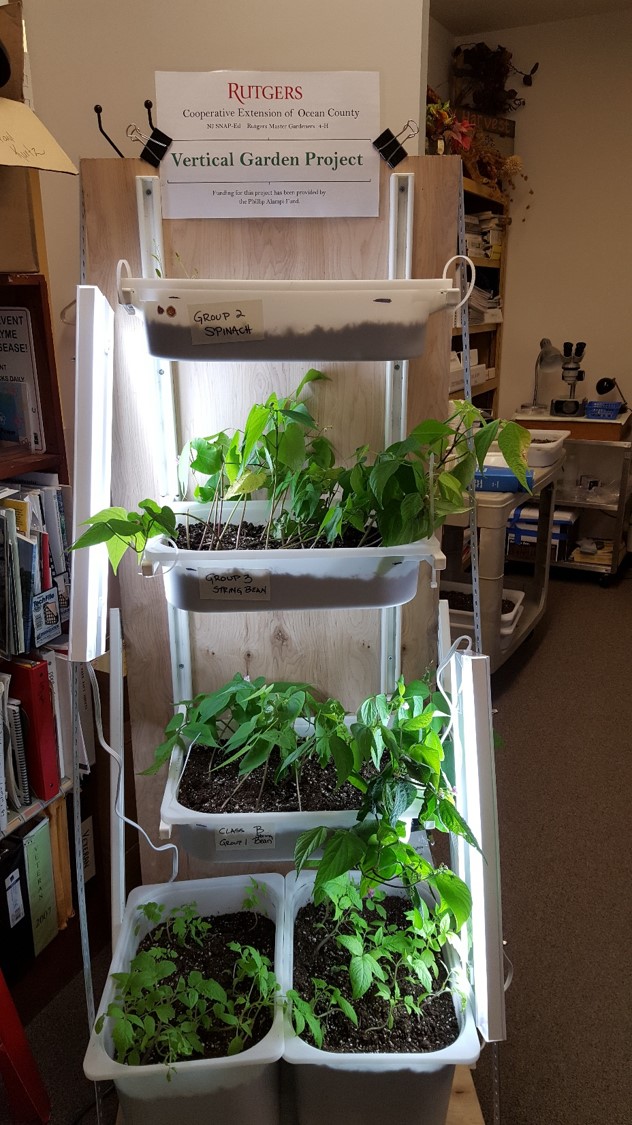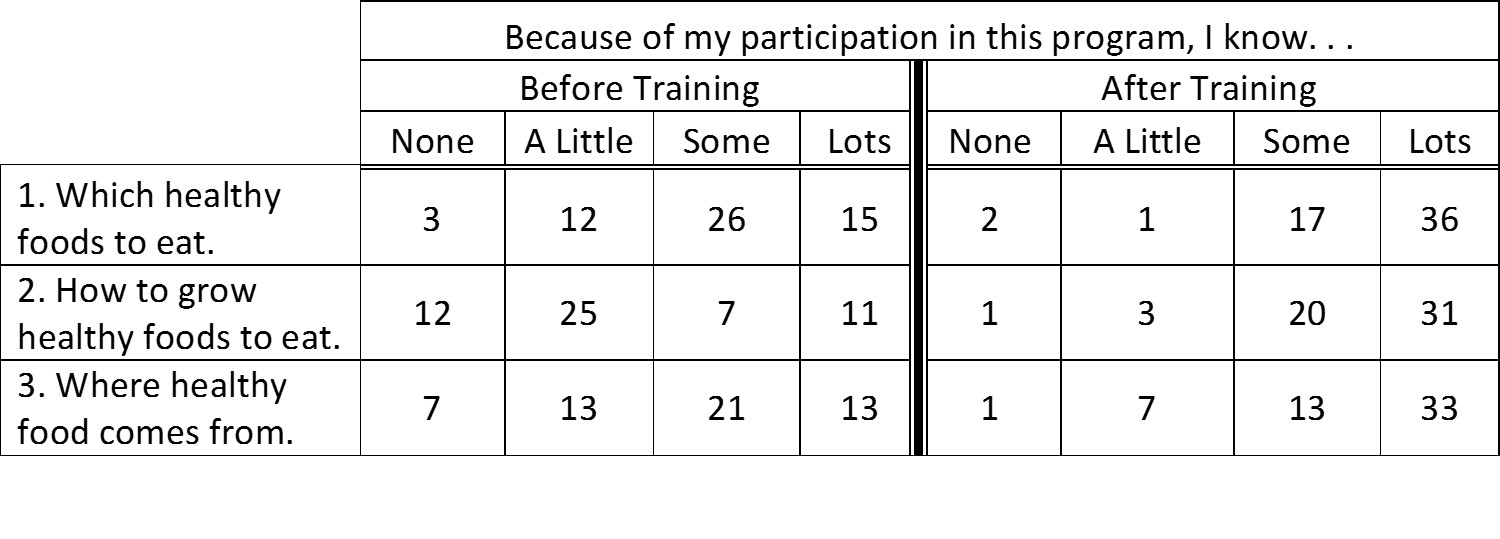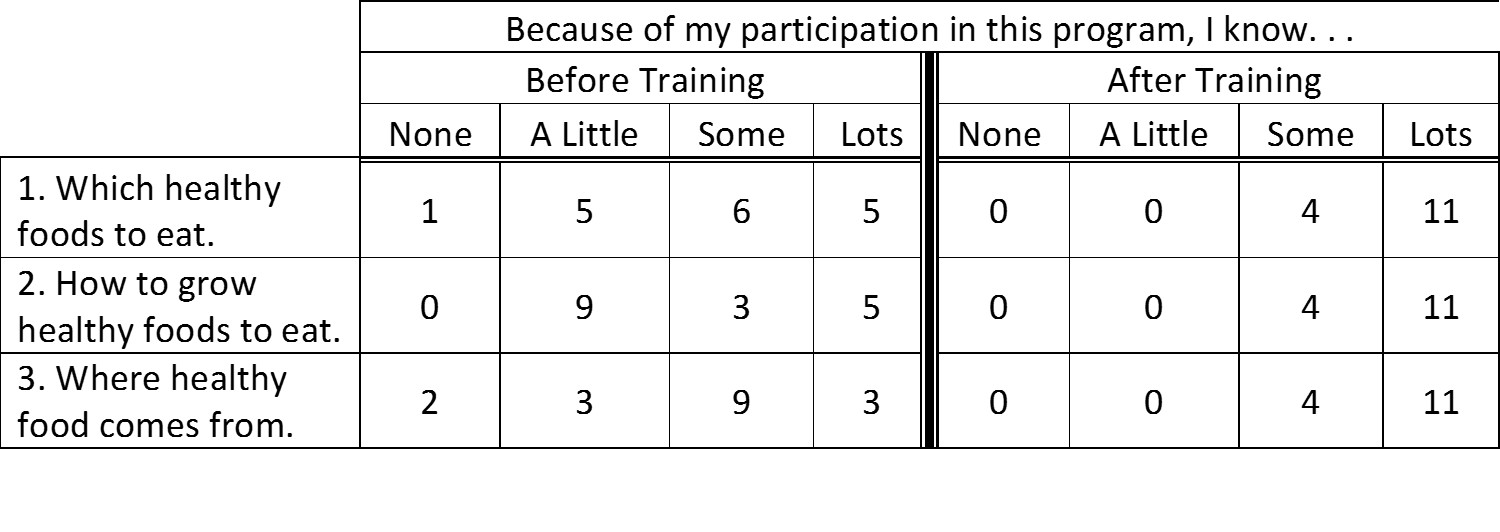Journal of the NACAA
ISSN 2158-9429
Volume 11, Issue 2 - December, 2018
Evaluation of a Vertical Garden Education Program
- Yergeau, S. , Environmental and Resource Management Agent, Ocean & Atlantic Counties, Rutgers Cooperative Extension
Emhardt-Servidio, S., Horticulturist, Ocean County, Rutgers Cooperative Extension
Pellien, T., 4-H Agent, Ocean County, Rutgers Cooperative Extension
Greene, A., NJSNAP-ED Program Associate (Formerly), Ocean County, Rutgers Cooperative Extension
ABSTRACT
A vertical garden education program was planned and implemented to determine its effectiveness as a substitute for traditional school gardens. Eight weekly lessons were conducted in January through March of 2017 at two schools (one elementary and one middle school) and involved a mixture of lecture and hands-on growing of vegetables on the vertical gardens. A post-instruction evaluation found that students showed an increase in their knowledge of nutritional foods and growing vegetables. These results show that vertical gardens are an option for schools that do not have the space for a traditional school garden.
INTRODUCTION
Using school gardens to enhance student instruction has a long history in education (Kohlstedt, 2008). The many benefits of using school gardens have been recognized (Graham et al., 2005), with the majority of advantages being focused on increasing students’ consumption of fruits and vegetables (Berezowitz et al., 2015; Lineberger and Zajicek, 2000; Ratcliffe et al., 2011; Rodriguez et al., 2015). The ability to connect a student to the origins of their food and how it is grown are valuable lessons that educators can use to reinforce other academic areas, such as the STEM (science, technology, engineering, and math) disciplines (Berezowitz et al., 2015; Ratcliffe et al., 2011).
The benefit of using school gardens in nutrition education is important for communities of underserved and vulnerable youth, which are often located in large urban centers or have other challenges (Ghosh-Dastidar et al., 2014). Population growth and associated development have the potential to decrease the green spaces available for schools to install traditional school gardens. In addition, high-density underserved communities are particularly susceptible to health issues associated with poor access to nutritional food choices (Ghosh-Dastidar et al., 2014).
To assist schools with inadequate space for a garden, Rutgers Cooperative Extension (RCE) of Ocean County developed and implemented a vertical garden education program. This program was designed to bring vegetable gardens into the classroom and provide hands-on educational opportunities on horticulture and healthy eating using a vertical garden. A vertical garden grows plants on a vertical surface either in pockets to hold the plants or on shelves where the plants are stored (Figure 1). These systems require less space than a traditional school garden, where space typically is at a premium for highly developed communities.

Figure 1. Completed vertical garden showing growth after the eight weeks of lessons. Vegetables grown (from top to bottom) were spinach (already harvested), wax beans, green beans, and tomatoes.
METHODS
Vertical Gardens
Two mobile vertical garden units were constructed following the instructions provided by Scarponi (2013). These instructions were modified from the original design. The original design was for growing the vegetables hydroponically, but the vertical gardens in this program used soil media (Pro-Mix BX) for growing the vegetables (Figure 1). The modifications also included reinforcing the vertical garden and attaching locking wheels to the units to ensure student safety. Each vertical garden had four sets of brackets on which trays, filled with soil, were attached to grow vegetables (Figure 1). Vegetables selected for growing included fast-growing greens, such as varieties of lettuce and spinach, and varieties of tomatoes and beans.
Course Design
Eight weekly lessons were developed and delivered in the classroom as a combination of lecture and hands-on instruction with the vertical gardens.
The following learning objectives guided the design of the vertical gardening program’s curriculum:
- Students will be able to identify and list healthy foods and their benefits.
- Students will be able to describe what is needed for plants to grow successfully.
- Students will be able to complete planting and caring for vegetable plants on a vertical garden.
- Students will be able to identify the origin of heathy foods.
Two different schools were chosen to participate in this program: 4th grade students at an elementary school in Seaside Heights, NJ, and two 6th grade classes at a middle school in Lakewood, NJ. The schools selected to participate in the program are located in areas where there was inadequate space for a traditional school garden. School grounds either had sandy areas where vegetables would not grow easily or there were restrictions on usage of the grounds and the costs for a traditional school garden. Both schools are SNAP-Ed (Supplemental Nutrition Assistance Program) eligible schools serving underserved youth in Ocean County. In addition to the eight weeks of gardening lessons, Ocean County SNAP-Ed staff and educators conducted lessons on nutrition and healthy living to these same classes for another four weeks.
Course Content
Weekly lessons were designed to introduce students to gardening and cultivating vegetables. Topics included the proper care of edible plants, soil health, and pest management. Each weekly lesson covered approximately 40 minutes of instruction per class in the following areas:
- An overview of different methods of growing vegetables
- Seed starting
- Components needed for plant growth (water, nutrients, sunlight)
- Garden maintenance
- How vegetables are harvested
All lessons conducted during the eight week sessions were adapted from a combination of a hydroponics curriculum developed by 4-H of Ocean County and the SNAP-Ed curriculum “Growing Healthy Habits” (https://snaped.fns.usda.gov/library/materials/growing-healthy-habits). The specific units from “Growing Healthy Habits” used during the eight weekly lessons included ‘Keep It Growing’, ‘Seed Magic’, and ‘Feed the Soil…and the Soil Will Feed You!’ All of these lessons incorporate the topics outlined in the weekly lessons, as described above.
The additional lessons provided by Ocean County SNAP-Ed staff were also based on the “Growing Healthy Habits” curriculum. Lessons used over four weeks included ‘Understanding MyPlate’ (focusing on the food groups and healthy food options), ‘Parts of the Plants We Eat’ (introducing plant anatomy and what foods originate from these parts), and ‘Keeping It Growing’ (teaching the science behind maintaining a garden).
Trained Rutgers Master Gardeners of Ocean County conducted the lessons in coordination with the Ocean County Horticulturalist and under the supervision of the appropriate teacher at each school. Previous work on school gardens has shown that teachers view Master Gardeners as experts and value their knowledge on horticultural issues (DeMarco et al., 1998).
Evaluation
A three-question retrospective evaluation was used to determine the effectiveness of the weekly lessons and the program overall. The evaluation was a post-program retrospective tool that the students used to rate their level of knowledge on a 4-level scale (knowledge = none, a little, some, or lots) before and after the eight weeks of lessons.
Statistical Analysis
Paired sample F-tests and t-tests were used to analyze differences in the before and after evaluations. A significance level of p < 0.05 for all statistical tests was considered significant. Statistical analyses were conducted using the statistical software package in Microsoft Excel™.
RESULTS
Eight weekly lessons were conducted in January through March in 2017 to two 6th grade classes in Lakewood, NJ and one 4th grade class in Seaside Heights, NJ. An average of 53 6th grade students and an average of 17 4th grade students attended each weekly lesson.
A pre- and post-evaluation was administered to the students at each school to gauge the program’s effect on students’ abilities to select healthy foods and grow vegetables in a vertical garden. Participants estimated their level of knowledge with a 4-level evaluative scale (knowledge = none, a little, some, or lots) on three questions after the eight weekly lessons in March 2017 (Table 1; Table 2).
Table 1. Results of student self-evaluation after the vertical garden program for the two 6th grade classes.

Table 2. Results of student self-evaluation after the vertical garden program for the one 4th grade class.
|
|
The number of students that ranked their knowledge as ‘None’, ‘A Little’, or ‘Some’ in the pre-evaluation decreased after receiving the program in both schools (Table 1; Table 2). Those who ranked their knowledge as ‘Lots’ showed an increase from pre- to post-evaluation on all three questions (Table 1; Table 2). The 6th grade students who ranked their knowledge as ‘Lots’ increased by 140%, 182%, and 154% for questions #1, #2, and #3, respectively (Table 1). The 4th grade students who ranked their knowledge as ‘Lots’ increased by 120%, 120%, and 267% for questions #1, #2, and #3, respectively (Table 2).
The difference between students who rated their knowledge as ‘Lots’ before and after the program showed a significant increase (t = 2.13, p = <0.05).
DISCUSSION and OUTCOMES
School gardens have proven to be a valuable hands-on tool for teaching students about horticulture and nutrition. For those schools that have the resources, particularly space to locate a garden, the benefits are numerous. However, some schools may not have the physical space available to build a traditional school garden. Options for these schools need to be available so students do not lose the opportunity to gain meaningful education on horticulture and nutrition.
This program assisted schools with addressing the challenges of funding and space by bringing vegetable gardens into the classroom and providing hands-on educational opportunities in horticulture and healthy eating through a vertical garden. Many school districts face the challenges of limited funds for project-based learning and a decreasing amount of green spaces for activities related to gardening or the environment. Rather than utilize a traditional school garden, the project partners worked with two schools in Ocean County to plan, plant, and maintain a vertical garden in their classrooms. By growing the plants on a vertical surface, less space is required than a traditional school garden, which is at a premium for highly developed towns in Ocean County.
The results from the students’ self-evaluation show that the vertical garden education program was successful in increasing the students’ knowledge at the schools that participated (Table 1; Table 2). This indicates that a structured vertical garden program is an option that could be used in place of a traditional school garden.
One challenge experienced by the educators was the short 40-minute periods in which the lessons were conducted. Future work with the vertical garden program will include the development of an after-school program, which will allow educators to expand the length of each lesson from the original 40 minutes to one hour and possibly one and a half hours.
RCE of Ocean County is committed to helping its diverse population adapt to a changing landscape while improving their lives with an educational and action-oriented process that uses science-based knowledge to improve their health and well-being. A vertical garden program is one means to accomplish this goal.
LITERATURE CITED
Berezowitz, C.K., Bontrager Yoder, A.B., and Schoeller, D.A. (2015). School gardens enhance academic performance and dietary outcomes in children. Journal of School Health, 85(8):508-518.
DeMarco, L., Relf, D., and McDaniel, A. (1998). Extension Master Gardeners valued by teachers in school gardening programs. Journal of Extension, 36(5), 5RIB4. Available at https://www.joe.org/joe/1998october/rb4.php.
Ghosh-Dastidar, B., Cohen, D., Hunter, G., Zenk, S.N., Huang, C., Beckman, R., and Dubowitz, T. (2014). Distance to store, food pantries, and obesity in urban food deserts. American Journal of Preventative Medicine, 47(5):587-595.
Graham, H., Beall, D.L., Lussier, M., McLaughlin, P., and Zidenberg-Cherr, S. (2005). Use of school gardens in academic instruction. Journal of Nutrition Education and Behavior, 37(3):147-151.
Kohlstedt, S.G. (2008). “A better crop of boys and girls”: the school gardening movement, 1890-1920. History of Education Quarterly, 48(1): 58-93.
Lineberger, S.E. and Zajicek, J.M. (2000). School gardens: can a hands-on teaching tool affect students’ attitudes and behaviors regarding fruits and vegetables? HortTechnology, 10(3):593-597.
Ratcliffe, M.M., Merrigan, K.A., Rogers, B.L., and Goldberg, J.P. (2011). The effects of school garden experiences on middle school-aged students’ knowledge, attitudes, and behaviors, associated with vegetable consumption. Health Promotion Practice, 12(1): 36-43.
Rodriguez, M.T., Lamm, A.J., Odera, E., Owens, C., and Thompson, S. (2015). Evaluating impacts of school-based Extension garden programs from a child’s perspective. 53(1), 1RIB4. Available at https://joe.org/joe/2015february/rb4.php.
Scarponi, A. (2013). Eliooo: how to go to IKEA® and build a device to grow food in your apartment. Zurich, Switzerland: ThirdO Books.
ACKNOWLEDGEMENTS
The authors wish to thank the Phillip Alampi Fund for providing funding for construction of the two vertical gardens and their supplies used in this project. The authors also wish to thank the teachers and school administrators for their help in implementing this project.

